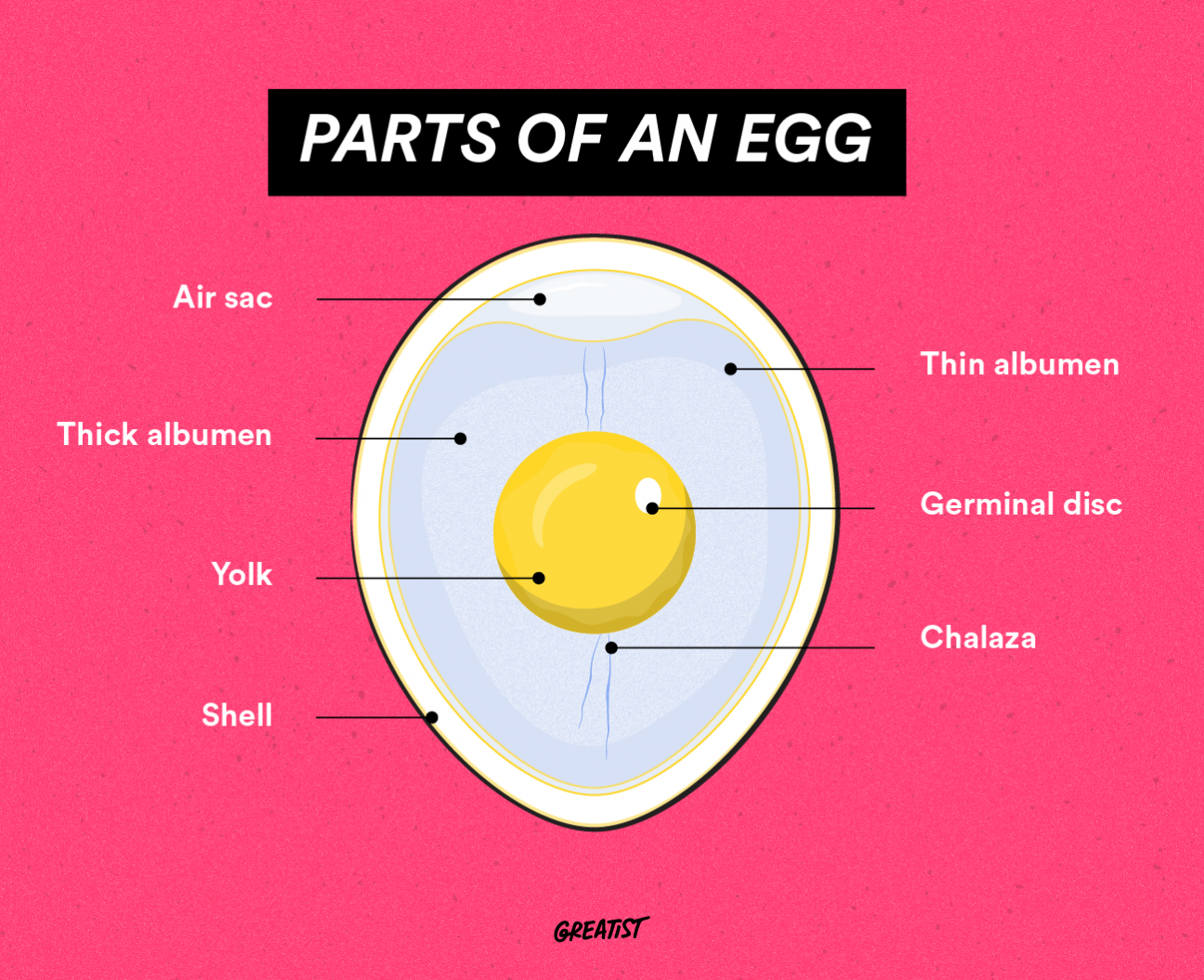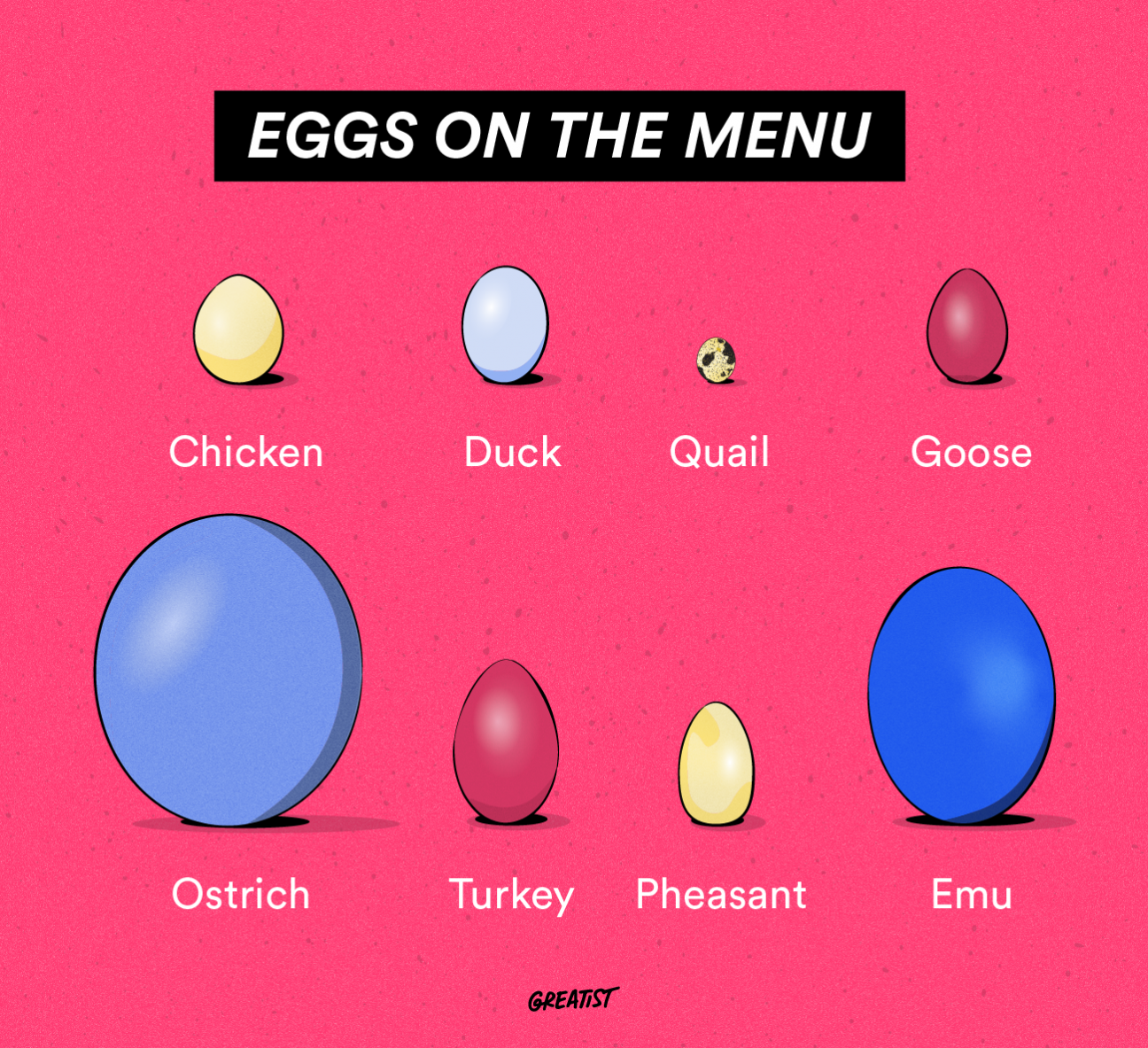Often referred to as “nature’s multivitamin,” bird eggs might be the perfect food. They boast 12 grams (g) of protein and 10 g of fat (per 100 g of eggs) and pack more than 10 percent of the recommended daily intake of multiple B vitamins, as well as trace amounts of calcium, iron, potassium, zinc, manganese, vitamin E, and folate — just about everything a human body needs to function properly.

But beyond the health perks, there are SO many reasons to love eggs. They’re easy to come by and inexpensive as sh*t (a dozen for less than the price of a Starbucks Frappuccino), they stay good in the fridge for a while, and you can transform them in mere minutes into savory scrambles, spicy shakshukas, poached toast toppers, and fried egg sammies.
Wanna level up? Eggs can also morph into veggie-flecked frittatas, cheesy quiches, egg salads, Benedicts, burritos, and more. And that’s before we get into eggs-istential sweets like cakes, cookies, pancakes, waffles, and meringues. Of all the foods in the world, eggs can do just about everything — breakfast, lunch, dinner, dessert, and snacks!
Anatomy of an egg
Eggs might look simple on the surface, but there’s a lot going on inside! If you’ve ever cracked open an egg and wondered “Is that squiggly thing normal?”, you’re not alone. No matter what kind of egg you’re eating (chicken, duck, quail, etc.), every egg has the following parts:

- Shell. This hard but slightly porous outer coating protects the internal structures from damage and the world outside.
- Thin albumen. This is the thin, slightly watery outer part of the egg white (egg white is a combination of protein and water).
- Thick albumen. This is the protein-rich egg white itself.
- Chalaza. That sorta stringy thing found inside raw eggs, the chalaza (also made of protein) attaches the yolk of the egg to the shell. It’s gross-looking but very important!
- Yolk. This is the cholesterol-rich, yellow center of every bird egg, where the vitamins and other nutrients are stored.
- Germinal disk. This is the small, circular white spot on the surface of the yolk that, if fertilized, will begin to grow into a baby bird. Don’t worry — this is extremely unlikely in the case of grocery store eggs.
- Air sac. Just what it sounds like, this is a small pocket of air trapped inside the egg. When you’re peeling hard-boiled eggs, this bit of space is what (usually) helps you separate the shell from the white.
One weird trick to tell if an egg is old
Fill a glass or bowl with water and place your egg inside. The air sac inside the egg expands as the egg ages, which means older eggs will float. That doesn’t necessarily mean they’re “bad” eggs, though. Crack one open and check it for weird smells before deciding to keep or toss it.
Eggs sold in the United States must be refrigerated and will stay good for at least 3 to 5 weeks after purchase, often past the “sell by” date on the packaging.
Chicken eggs
The status quo of avian eggs, the most commonly consumed egg, is without a doubt the chicken egg.
Chickens live in every country in the world (except Vatican City) and can be found on every continent except Antarctica — there are roughly 20 billion chickens strutting and squawking around the world at any given time. Given their numbers (and the important nutrients packed within their shells), it’s likely everyone, minus the lifelong vegans of the world, has eaten a chicken egg at some point.
The USDA recognizes six sizes, or weight classes, for chicken eggs: peewee, small, medium, large, extra-large, and jumbo. Size is determined by the weight per dozen, not the size or weight of each individual egg. The size of an egg depends on a few things, including the age and breed of the chicken. Hens in their prime typically lay medium and large eggs. The USDA also categorizes eggs by quality.
Cage-free, free-range, organic? What does it all mean?
These terms can be confusing! The U.S. government only requires eggs to be labeled “certified organic” — everything else can be provided by egg farmers at their own discretion.
There are many other certification programs that offer regulations and guidelines for farmers to follow, but again, those are optional.
Here are basic definitions for some of the most common terms you might see:
- Cage-free. Hens aren’t confined to cages and may roam free with access to food and water, though they likely don’t have access to the outdoors. Conditions may still be cramped and uncomfortable.
- Free-range. These eggs are laid by hens who aren’t confined to cages and can roam free with access to food, water, and the outdoors, though the quality of that outdoor space can vary. How much space each chicken is guaranteed also varies according to different certifying organizations.
- Organic. Organic eggs are laid by hens who don’t live in cages and are fed “an organic diet of feed produced without conventional pesticides or fertilizers,” according to the USDA. The hens generally have access to outdoor space, but again, the quality of that space is not regulated.
- Pasture-raised. Pasture-raised hens have access to a large pasture covered primarily with living greenery and vegetation and a generous amount of pasture per bird. These eggs tend to be more expensive.
At your local grocery store, you’re most likely to encounter large, extra-large, or sometimes jumbo eggs. I’ve personally never seen size small or peewee chicken eggs for sale (all the small eggs at most U.S. grocers are duck or quail eggs — more on those in a bit).
So most of us use large or extra-large eggs. (A recipe calling for “two eggs” is likely not going to go as planned with peewee, small, or jumbo eggs.)
Not sure which size egg to use?
When in doubt, choose large eggs! Large is considered the standard egg size for baking and cooking.
Because large chicken eggs are the ones most commonly used in cooking and baking, and because eggs are used in SO MANY different kinds of recipes, there are some super useful numbers and rules to know. Like, what do you do if your recipe calls for large eggs and you have only extra-large or jumbo on hand?
Boom — here’s the math:
- 3 large eggs = 3 medium eggs OR 3 extra-large eggs OR 2 jumbo eggs
- 4 large eggs = 5 medium eggs OR 4 extra-large eggs OR 3 jumbo eggs
- 5 large eggs = 6 medium eggs OR 4 extra-large eggs OR 4 jumbo eggs
- 6 large eggs = 7 medium eggs OR 5 extra-large eggs OR 5 jumbo eggs
Knowing the weight of a large egg white (1 ounce) can be really helpful if you’re making, say, an egg white-based recipe that calls for 5 ounces of egg whites (that’s the whites from 5 large eggs) or if you or someone you know and love (or socially tolerate) is deeply diet-focused and needs to know just how much fat and/or protein is going into a dish.
Being aware that egg whites cook at a higher temperature (175º F/80°C) than egg yolks (158º F/70°C) can also help avoid any icky over- or underdone breakfast situations.
Chicken eggs aren’t just white and brown
While store-bought eggs in the United States are often white or brown, hens of different species actually do lay eggs in different colors, including shades of blue and green. The determining factor? The chicken’s earlobes. True story.
Other bird eggs you can eat and where to find them
Chicken eggs aren’t the only ones that provide these treats and benefits. Humans can safely eat eight kinds of bird eggs. Chicken, duck, quail, goose, turkey, emu, ostrich, and pheasant eggs can all be fried, scrambled, or hard-boiled; used in cakes, cookies, and pies; or even shaken up in a cocktail, although if you’re working with ostrich eggs, I hope you’re not eating — or drinking — alone.
- Duck eggs. Duck eggs are about 50 percent larger and weigh more than chicken eggs as a result of their higher fat content. They’re excellent for baking — those extra ounces of fat equal fluffier cakes, richer breads, and more gravity-defying meringues.
- Quail eggs. Approximately half the size of a large chicken egg, these eggs are a light beige color speckled with dark brown spots. Quail eggs are an especially popular street food item in the Philippines, where orange-battered and fried eggs called kwek kwek are sold by the dozens to passersby.
- Turkey eggs. While they’re fully edible, turkey eggs don’t often make it to markets or stores. Fully grown turkeys are more valuable to farmers and, well, they need those eggs to hatch into someone’s main dish for Thanksgiving.
- Goose eggs. If you find a goose egg in the wild or on a menu, it’ll be about twice the size of a chicken egg and much denser when cooked due to thick yolks and high protein content (1 goose egg supplies about 20 grams of protein). Goose egg yolks are highly sought-after by pasta makers and are credited with making the perfectly textured noodle.
- Pheasant eggs. Pheasants lay eggs twice the size of quail eggs. These eggs have olive green or brown shells and are frequently used in egg-based dishes in the U.K.
- Ostrich eggs. Ostrich eggs are the largest of the edible bird eggs, weighing about 3 pounds apiece. They have runny yolks similar to those of chicken eggs, so they can be fried or scrambled — if you can get them open.
- Emu eggs. The deep blue-green color of emu eggs makes them look like something from outer space, but they are edible. They’re lighter than ostrich eggs but very different on the inside. Their fat content is so high that if you opened one, even raw, you’d need to do some wiggling to get the gooey insides out of the shell.
Emu eggs: On the menu
Because of their size, richness, and — let’s be honest — striking appearance, emu eggs were fairly hot a few years ago as a novelty food chefs liked to play with. In 2017, the menu of a West Village restaurant offered a soft-scrambled emu egg with black truffle and wild mushrooms that served two to six people — for $90.
Bird eggs by the numbers
If you’re feeling really adventurous (or you’re stranded in the woods or the Australian bush), here’s how other types of bird eggs compare with the kitchen gold standard of the large chicken egg.
| Weight, including shell (oz) | Protein (g) | Fat (g) | |
|---|---|---|---|
| Chicken (large) | 2.0 | 7 | 5 |
| Duck | 2.5 | 9 | 9.7 |
| Turkey | 3.5 | 14 | 12 |
| Pheasant | 2.8 | 11 | 9.4 |
| Quail | 0.3 | 1.2 | 1.0 |
| Goose | 5 | 20 | 19 |
| Ostrich | 48 | 168 | 120 |
| Emu | 21.5 | 72 | 38 |

Get your egg on with these recipes
- This fluffy omelet is so good it turned an egg hater into an egg lover.
- Try cracking a raw egg over rice for breakfast, a Japanese dish known as tamago kake gohan.
- Give Gordon Ramsay’s technique for superfluffy scrambled eggs a try.
- Turn eggs into a silky-smooth pasta sauce with this recipe for traditional Roman-style pasta carbonara.
- Learn how to make the perfect hard-boiled egg so you can fully appreciate Nancy Silverton’s genius egg salad recipe. And when you’ve conquered that, move on to making the perfect poached egg, which is such a good addition to salads, grain bowls, pasta, and of course, eggs Benedict.
- Crack a whole egg onto a pizza right before cooking to make a delicious breakfast pizza (for dinner or breakfast!).
Haley Hamilton is a Boston-based bartender and freelance writer with words in EATER; Bustle; MELMagazine; Catapult magazine; Boston’s alt-weekly, DigBoston; and elsewhere.

0 Commentaires